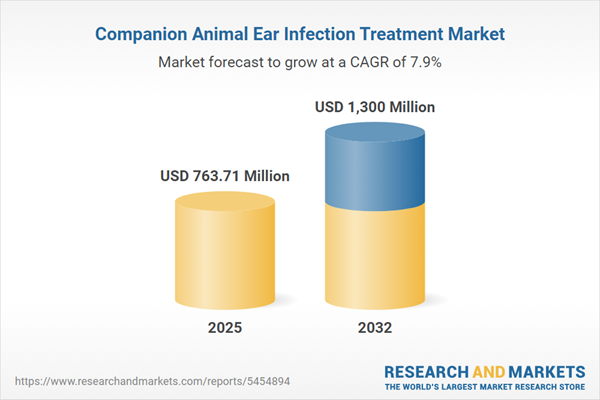Speak directly to the analyst to clarify any post sales queries you may have.
The companion animal ear infection treatment market is advancing as veterinary healthcare providers and industry leaders navigate increasing challenges related to antimicrobial resistance, clinical efficacy, and evolving care models. Strategic focus on innovation and supply chain adaptability is now crucial as sector complexity intensifies.
Market Snapshot: Companion Animal Ear Infection Treatment Market
The companion animal ear infection treatment market grew from USD 707.57 million in 2024 to USD 763.71 million in 2025. With a projected CAGR of 7.91%, the market is forecast to reach USD 1.30 billion by 2032. Rising incidence of otitis in both canine and feline patients, coupled with advancements in drug delivery systems and increasing adoption of point-of-care diagnostics, are driving the sector forward. Senior stakeholders are closely monitoring these shifts as new regulatory demands and clinical standards shape both risks and opportunities across geographies.
Scope & Segmentation of the Market
- Administration Modes: Systemic therapies (injectable, oral); topical regimens (ointments, solutions, suspensions)
- Animal Types: Cats, dogs
- Distribution Channels: Online pharmacies (manufacturer sites, marketplaces), retail pharmacies (chain, independent), veterinary clinics (independent practices, referral hospitals)
- Active Ingredient Classes: Antibiotics (aminoglycosides, cephalosporins, macrolides), antifungals (azoles, polyenes), combination therapies (antibiotic-antifungal, antibiotic-steroid)
- Regions: Americas (United States, Canada, Mexico, Brazil, Argentina, Chile, Colombia, Peru); Europe, Middle East & Africa (United Kingdom, Germany, France, Russia, Italy, Spain, Netherlands, Sweden, Poland, Switzerland, United Arab Emirates, Saudi Arabia, Qatar, Turkey, Israel, South Africa, Nigeria, Egypt, Kenya); Asia-Pacific (China, India, Japan, Australia, South Korea, Indonesia, Thailand, Malaysia, Singapore, Taiwan)
- Company Analysis: Zoetis Inc., Merck & Co., Inc., Elanco Animal Health Incorporated, Boehringer Ingelheim International GmbH, Ceva Santé Animale S.A., Virbac SA, Dechra Pharmaceuticals PLC, Vetoquinol SA, Norbrook Laboratories Ltd., Bimeda Inc.
Key Takeaways for Decision-Makers
- Veterinary practitioners and industry operators face increasing pressure to balance clinical effectiveness with antimicrobial stewardship principles. Treatment selection is evolving towards evidence-based protocols to address resistant infections and patient safety.
- Systemic and topical therapies are both advancing, with novel delivery platforms such as sustained-release implants and improved dosage forms enhancing compliance and clinical outcomes.
- Species-specific product design is driving innovation, with tailored formulations developed for both canine and feline anatomical differences to maximize comfort and therapeutic impact.
- Digital technologies are reshaping care delivery and monitoring. Artificial intelligence-powered diagnostics and telemedicine platforms are expanding specialist access, improving treatment precision and collaboration across veterinary networks.
- Regional trends significantly influence product uptake. Markets in North America benefit from integrated regulatory pathways, while Asia-Pacific regions leverage local partnerships and digital prescription models to accelerate growth.
- Portfolio differentiation and end-to-end supply chain management are essential for competitive positioning. Leading companies are strengthening global reach through partnerships, acquisitions, and technology integration.
Tariff Impact on Supply Chains
Recent U.S. tariff measures have altered cost structures and brought new complexities to sourcing and regulatory management. Manufacturers are adapting by pursuing long-term supplier agreements, exploring alternative materials, and investing in customs compliance. These shifts affect inventory strategies and prompt veterinary clinics and pharmacies to collaborate more closely with manufacturers, reinforcing overall supply chain resilience in companion animal healthcare.
Methodology & Data Sources
This report synthesizes primary interviews with veterinary clinicians, pharmacologists, regulatory experts, and distribution leaders, alongside reviews of academic literature, regulatory documents, and industry white papers. Analytical frameworks, including SWOT and regression analyses, provide comprehensive context and cross-validate insights to ensure data reliability and depth.
Why This Report Matters
- Enables informed investment and operational decisions by providing granular market segmentation and actionable strategic insights.
- Helps senior leaders clarify innovation priorities, respond to regulatory and trade shifts, and benchmark competitive positioning in a dynamic global environment.
- Highlights pathways for resilient growth through supply chain optimization, digital innovation, and product portfolio diversification.
Conclusion
Strategic adaptation to market shifts, technology integration, and collaborative supply chain management will remain pivotal for industry leaders. This companion animal ear infection treatment market report equips stakeholders with reliable intelligence to navigate change and capture emerging opportunities.
Additional Product Information:
- Purchase of this report includes 1 year online access with quarterly updates.
- This report can be updated on request. Please contact our Customer Experience team using the Ask a Question widget on our website.
Table of Contents
3. Executive Summary
4. Market Overview
7. Cumulative Impact of Artificial Intelligence 2025
Companies Mentioned
The companies profiled in this Companion Animal Ear Infection Treatment market report include:- Zoetis Inc.
- Merck & Co., Inc.
- Elanco Animal Health Incorporated
- Boehringer Ingelheim International GmbH
- Ceva Santé Animale S.A.
- Virbac SA
- Dechra Pharmaceuticals PLC
- Vetoquinol SA
- Norbrook Laboratories Ltd.
- Bimeda Inc.
Table Information
| Report Attribute | Details |
|---|---|
| No. of Pages | 191 |
| Published | October 2025 |
| Forecast Period | 2025 - 2032 |
| Estimated Market Value ( USD | $ 763.71 Million |
| Forecasted Market Value ( USD | $ 1300 Million |
| Compound Annual Growth Rate | 7.9% |
| Regions Covered | Global |
| No. of Companies Mentioned | 11 |









